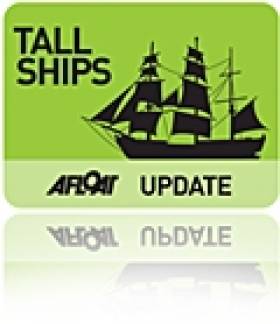Displaying items by tag: LE Deirdre
Dublin’s Tallship Link to Parade of Sails Naval (Guard) Ships
#TALL SHIPS – At the Dublin Tall Ships Races Festival, the docklands-based replica 19th century barque Jeanie Johnston was open to the public, however a former Irish Naval Service vessel, could of been there in her place, had circumstances in the past had taken a different course, writes Jehan Ashmore.
Since 2005, the Jeanie Johnston has been owned by the Dublin Docklands Development Authority (DDDA) which as part of its remit was to regenerate water-borne activity along the Liffey. In May this year it was announced the authority is to be wound-down over a period of 18 months.
The Jeanie Johnston currently serves as a static floating emigrant famine museum. This is a stark contrast to when the barque made a historic re-enactment voyage in 2003 of her predecessor which carried Irish emigrants across the Atlantic, between 1845-1855 to Quebec, Baltimore, and New York.
Prior to the acquisition of Jeanie Johnston by the DDDA, the L.E. Deirdre (P20) was decommissioned four years previously when the Naval Service put her up for auction. She is an elder half-sister of the L.E. Emer (P21) which performed 'guardship' duties during last Sunday's Parade of Sail off Dun Laoghaire Harbour.
Notably the L.E. Deirdre is historically significant in that she was the first custom-built newbuild for the Naval Service and also the first such vessel built in the country, at Verolme Cork Dockyard in 1972, however despite campaigns to keep her as part of our national maritime heritage, this did not materialise, as she was sold at a bargain price of £180,000 to a UK company.
Initially this saw the vessel go to the ship-repair yard of Pomerania, in Szczecin, ironically the Polish city which was the presenting sponsor of the Dublin Tall Ships Races Festival in association with Sail Training International (STI).
However the owner of the former Naval Service vessel, died in 2004, and work on transforming the offshore patrol vessel into a luxury charter yacht, which included installing a helicopter landing pad, came to a standstill. She was sold again and towed to Brazil in 2005 where it is believed the 220ft vessel renamed Santa Rita, painted beige replacing the dull naval grey, was to be completed in 2010.
Yesterday L.E. Emer departed Dublin Port to resume routine patrols and the last large tallship to bid the capital farewell, the A-class, Italian Navy's Amerigo Vespucci, was underway last night. This leaves the Swedish Navy's gaff schooner Falken (class-B) as the last of the tallships still in port.
Navies Northern Adventure Head for 'Foyle Days'
On the naval front, LE Emer was built in Cork's Verolme Dockyard in 1978. She represents the oldest of the eight-strong fleet and is designed from the Naval Service's first purpose built patrol vessel OPV LE Deirdre (P20) but was modified to improve her stability and speed. This vessel was decommissioned several years ago and was converted into a private yacht.
The original BOFORS 40mm L60 gun of the LE Emer was recently upgraded to a BOFORS 40mm L70 to improve range and accuracy of her main armament. She alongside her 65m sisters LE Aoife (P22) and LE Aisling (P23) where all built primarily to patrol the Irish section of the European Economic Zone (EEZ).
During their careers the 'Emer' class vessels have also completed numerous re-supply missions to Irish troops serving overseas with the United Nations and in particular in the Lebanon. A crew compliment of 46 (5 officers) operate the vessels which are all now in their fourth decade of service.
OPV HMS Severn is the third of four 'River' class offshore patrol vessels and like her Irish counterpart is deployed on fishery duties. The 1,677 displacement tonnes vessel was built in 2001 in the UK'S south coast port of Southampton at Woolston Docks. Her home port for the 30 crew is at HM Naval Base in neighbouring Portsmouth.
She becomes the fifth ship to bear the name and with sisters HMS Mersey (P 282) and HMS Tyne (P 281) they are assigned to the Fishery Protection Squadron. Click the ship's diary to follow the ship news. The final member of the River class HMS Clyde (P 257) serves as a Falklands Islands Patrol Vessel (FIPV).
- yacht
- Clipper Round The World Race
- naval service
- Derry
- Royal Navy
- Londonderry
- Ports and Shipping News
- JOHANNA LUCRETIA
- Verolme Cork Dockyard
- United Nations
- Foyle Days
- Offshore Patrol Vessel
- Maritime Festivals
- LE Emer
- Emerclass
- LE Deirdre
- HMS Mersey
- Riverclass
- Schooner
- HM Naval Base Portsmouth
- Falklands Islands






























































